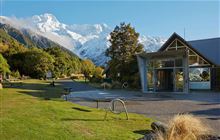Advice on DOC's Visitor Centre Strategy
Introduction
23 August 2021: Read the NZCA's advice to the Minister and Director General of Conservation regarding the Department's Visitor Centre Strategy 2020-25.To: Hon Kiritapu Allan, Minister of Conservation
Cc: Lou Sanson, Director-General of Conservation
Date: 23 August 2021
On 18 May 2021, the New Zealand Conservation Authority (Authority) received a letter from Federated Mountain Clubs regarding the Department of Conservation’s (Department’s) Visitor Centre Strategy 2020-25 (Strategy). The Authority have sought to review the Strategy via its Tourism Committee and provide feedback to you.
The Conservation Act 1987 (Act) clearly outlines that the Department has an important role in the dissemination of information that advocates for and promotes the conservation of natural and historic resources.
One means by which the Department has sought to perform this statutory function is by way of DOC Visitor Centres. These visitor centres are, indeed, an excellent means of deepening knowledge and appreciation of the heritage, culture, and conservation efforts throughout Aotearoa. They offer an effective means of disseminating information at place, that is complimentary to the information on the Department’s website.
DOC Visitor Centre Strategy 2020-25
In reviewing the Strategy, the Authority bore in mind the importance and function of visitor centres outlined above. The Authority commends the Strategy on its recognition of the:
- need to invest in visitor centres; many of these centres are in poor condition, with limited ability to even provide full information on safety and recreation. Centres are often located in rented or temporary premises with limited space. The Department is, consequently, constrained in the quantity and quality of information it can include, and therefore, in its ability to strengthen knowledge and appreciation for the natural and historic heritage of Aotearoa.
- need to collaborate more effectively with Māori: iwi, hapū, and whanau, to enable delivery of a deeper story and experience at place. The involvement of tangata whenua and support of local communities at place is essential to developing visitor centres, and in upholding the Crown’s obligations as Treaty Partner.
- importance of visitor centres in providing natural, historic, and cultural heritage information to both domestic and international visitors. This is particularly true of the immediate ‘pre-planning’ and ‘doing’ phases of an experience on public conservation land. Visitors, whilst seeking recreation and safety information at a visitor centre, will likely encounter conservation related information they were not specifically looking for. Such encounters, combined with personal recreation experiences at site, are an effective means of increasing awareness and understanding of the natural environment and biodiversity; conservation efforts and issues, such as the climate crisis; and, the local histories of tangata whenua.
- potential in retail opportunities; there is an existing demand for national park branded products. The Authority would encourage a model by which the income generated from such an opportunity went towards species and heritage conservation.
The Authority notes significant concern regarding some elements of the Strategy, including in its process of development:
- There has been no iwi, hapū, and whanau, or wider community consultation in developing the Strategy; given the importance of this engagement noted within the Strategy, and above, this is truly a missed opportunity.
- The Strategy does acknowledge the under investment in visitor centres, however, there does not appear to be a clear pathway for increasing the level of investment to modernise even the priority centres. A model such as is accomplished at Aoraki/Mount Cook, whereby the visitor centre has become a visitor attraction in its own right, could be adopted elsewhere.
- Further to the point above, the visitor centres within group 2 ‘community sites’, receive little recognition of their need for investment and upgrading to mirror their potential and importance in disseminating information.
- Although visitor centres play an important role in communicating outdoor safety messages, the Authority is concerned that this appears to be the main focus within the Strategy, rather than to fulfil the Department’s primary mandate of conservation of natural and historic resources.
The primary purpose of a visitor centre is within the Department’s legislative mandate to prepare, provide, disseminate, promote, and publicise educational and promotional material relating to conservation. The investment in visitor centres cannot be weighted solely in a financial context (e.g. revenue generation vs cost). The Department’s education mandate requires investment in these centres to also be given appropriate weight.
Overall, the Authority finds that the Strategy leaves significant opportunity untapped; the Strategy fails to explore the potential that exists for the Department to disseminate information that advocates for and promotes the conservation of natural and historic resources.
No reira
E noho ora mai
Edward Ellison ONZM
Chairperson NZCA
Read the Department of Conservation's Visitor Centre Strategy 2020-25 (PDF,4,187K)
On 23 December 2021 the Department provided the following comment:
A Business Case to implement the DOC Visitor Centre Network Strategy is being developed. Implementation of this Strategy includes consultation and feedback. Further information about next steps to implement this Strategy will be communicated as implementation plans are developed. Questions or comments about this Strategy can be emailed to Colin McFetridge, Team Lead National Visitor Centres at: vcsupport@doc.govt.nz

